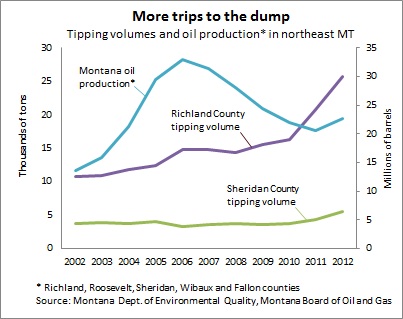As oil and gas drilling surges in western North Dakota, the effects are being keenly felt across the border in northeastern Montana.
For cities and towns on the western edge of the Bakken formation, the oil boom may have come and gone, as the state’s oil output has dropped by close to one-third since 2006, while North Dakota’s has skyrocketed. But many Montana communities in the region are nonetheless seeing rapid growth as service centers and bedroom communities for oilfields in North Dakota. Communities such as Sidney, Fairview and Bainville are only a 30 to 40 minute drive from Williston, N.D., in the heart of the Bakken.
Gauging population gains is difficult because Census counts and estimates typically undercount oilfield workers living in crew camps or someone’s basement. So state and local officials have turned to proxy measures to get a handle on the influx of people and determine how much of it is related to energy development in North Dakota.
One of those measures is the amount of trash hauled to municipal landfills—so-called tipping volumes. Data compiled by the Montana Department of Environmental Quality show that landfill tonnages at the Richland County Landfill near Sidney, which also serves Fairview, Bainville and other towns, increased moderately during the oil boom in eastern Montana in the mid 2000s (see chart). But dumping rose sharply after 2008, when oil production fell in the region but shot up in North Dakota. In contrast, a landfill in Sheridan County—farther from the core of the Bakken in extreme northeastern Montana—has seen only a slight tonnage increase in recent years.
“It’s a very clear indication that all of the activity that you see in eastern Montana counties is related to the development in North Dakota,” said Mark Haggerty, an economist with Headwaters Economics in Butte, Mont., who has seen the landfill data. The tipping index jibes with other metrics for northeastern Montana, such as subdivision proposals and traffic counts.
Unfortunately for local communities, resources are scarce to address the impact of oil-related spillovers on roads, sewage systems and other public services. Oil and gas production taxes paid by firms employing workers living in Montana accrue to North Dakota, not the Treasure State. Local governments in Montana see relatively little revenue from state oil and gas taxes because of production declines and lower effective tax rates compared with North Dakota.
For much more on the fiscal effects of the Bakken oil boom, look to the forthcoming July issue of the fedgazette.






